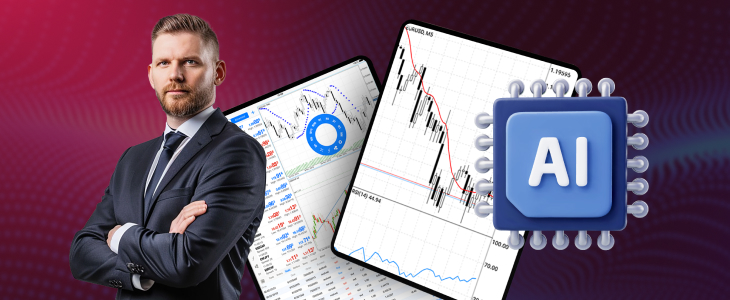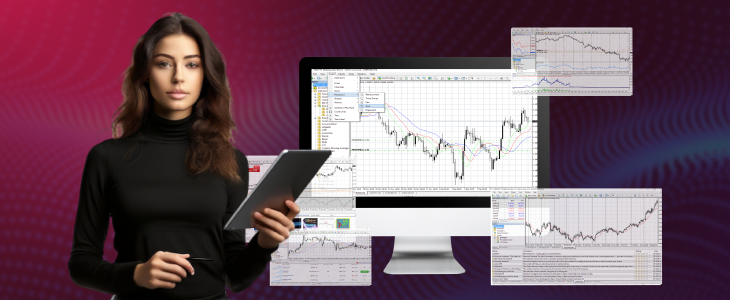The most liquid and most important financial market in the world is the forex market. Under its surface lies a complex system of systems, behavior, and cues called the forex market microstructure.
It is no longer an option for today’s institutions and traders to live without it; it is a necessity. Now that machine learning and artificial intelligence are joining the fray in currency trading, we find ourselves with incredibly powerful tools to open up this microstructure in real time.
From order flow analysis and liquidity action to price anomaly detection, AI-based insights for trading are transforming forex strategy construction and implementation quite literally. In this article, we’ll explore how AI intersects with the forex market microstructure and why this convergence is transforming the future of currency trading. So, let’s begin!

What is Forex Market Microstructure?
Forex microstructure is the cutting-edge research of how trading happens in the foreign exchange market. It’s not necessarily examining macroeconomic variables, but examining the inside of order flow, price formation, and interaction between other market participants like brokers, banks, and retail traders. It examines things such as bid-ask spreads, order book dynamics, and the realization of the information in currency prices in real time.
The Most Critical Forex Microstructure Challenges
Forex microstructure principles introduce the trader to numerous challenges. The volume and frequency at which this market produces information are gigantic and, therefore, unmanageable for humans to consume and react in time.
- Information overload: The FX market gives immense information in one second, e.g., price quotes, trades by volume, and order book updates. It is so vast that even human traders cannot possibly match and make smart decisions.
- High Volatility: The prices of currencies are rising due to such a large number of factors that it is hard to follow research recommendations and trade at the best price possible. It makes immediate losses or profits.
- Information Asymmetry: All agents in the market will not receive the same information at the same moment. Institutional traders will possess better information, and that is not optimal for retail traders.
- Risk of Execution: Even if the trader has a good trade idea, there is always a possibility that an order can fail to execute at the desired price, especially in ambiguous market situations or in instances of massive trade size.
- Market Manipulation: Whether the forex market is regulated or not, it is vulnerable to manipulation, and good price discovery becomes impossible, and not difficult for traders to believe in where the market is headed.
Role of AI in Forex Trading
Artificial Intelligence is turning forex trading into a world of new worlds at an exponential rate by adding advanced features much greater than the strength of traditional methods.
Its contribution to forex trading is such that:
- Enhanced Data Analysis: AI models are specifically trained to analyze vast quantities of historical as well as live market data, such as price action, traded volume, and sentiment of news. AI models are able to detect very subtle trends and relationships, which human traders miss and therefore take more informed decisions.
- Improved Risk Management: AI contributes greatly to risk management by analyzing market direction and computing optimal stop-loss and take-profit. AI can learn under different market conditions as a way of building capital, controlling probable losses, and safeguarding investors’ capital.
- Predictive Analytics: Artificial intelligence uses machine learning to precisely forecast future market trends from historical data and prevailing market trends. Its predictive function enables traders to organize pre-emptive rather than reactive measures in expectation of future price action.

How AI Sees Market Microstructure
Artificial intelligence learns market microstructure by analyzing humongous collections of trading data and revealing patterns that are not self-evident. Rather than just reading simple price charts, it drills deeper to learn how the market actually works behind.
- Order Book Analysis: AI is able to analyze real-time order book data such as bid and offer price, volume, and depth. It enables them to determine where the liquidity and price pressure points are.
- Order Flow Interpretation: By decomposing the order sequence and order size of sell and buy, AI is able to infer market mood and short-term price behavior better than conventional methods.
- Processing High-Frequency Data: AI processes the high-frequency data better, and as a result, it is able to capture the short-term opportunities and trade in milliseconds.
- Sentiment Analysis: AI can use natural language processing to examine economic reports, social media updates, and financial news websites. This helps it understand market sentiment and analyze how different events might affect currency prices.
- Pattern Recognition: AI systems can recognize advanced patterns in trading data that lead to future price action more than simple technical analysis.
สรุป
Forex AI trading, particularly in the area of market microstructure, is the Internet trading. The ability of AI to calculate large amounts of data, identify advanced patterns, and make trades effectively and efficiently provides enormous advantages for traders. Platforms like FXcess, which provide MetaTrader 4 and full CFD trading, are a step ahead in providing the facilities to traders to use such AI-based information, enabling informed decision-making a notch higher and the outcome improved in the fast-developing forex market.
With the new technology, the use of AI in examining and advisory services to forex traders on matters of market microstructure can only improve and become an absolute necessity for old and new traders alike.
FAQs
1. What is order flow analysis for forex trading?
Order flow analysis is the watching of buying and selling in the foreign exchange market to watch for the sentiment and direction of price as implied. It is a part of the microstructure and is sometimes supported by AI technology for real-time analysis.
2. What are the benefits of AI forex trading?
AI does have some strengths in forex trading, such as quicker processing of data, better prediction, the absence of emotional prejudice, and the capacity to find intricate patterns that human traders cannot.
3. How does machine learning enhance forex trading strategies?
Machine learning algorithms are powered by vast volumes of historical and real-time data, identify patterns, learn through patterns, and develop trading strategies faster and more efficiently.
การปฏิเสธความรับผิด
ข้อมูลนี้ไม่ถือเป็นคำแนะนำในการลงทุนหรือคำแนะนำในการลงทุน หากแต่เป็นการสื่อสารทางการตลาด
